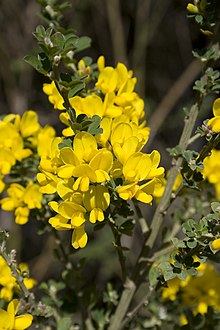**1. Genisteae Tribe Overview:**
– Emerged 32.3±2.9 million years ago in the Oligocene.
– Forms a monophyletic clade in molecular phylogenetic analyses.
– Morphological synapomorphies include bilabiate calyces and fused stamen filaments.
– Genera produce 5-methylgenistein and various alkaloids like quinolizidine alkaloids.
– Historical uses include emblem for Plantagenet kings, dye production, and culinary uses.
– Not a true genus but often treated as a section of Cytisus or Genista.
**2. Distribution and Importance:**
– Belongs to the subfamily Faboideae of the family Fabaceae.
– Diverse in the Mediterranean, Europe, Africa, Canary Islands, India, and southwest Asia.
– Largest genus, Lupinus, most diverse in North and South America.
– Used for ornamental landscaping and land reclamation.
– Naturalized invasive species in regions like the Pacific Northwest and southern Australia.
**3. Chemosystematics and Research Studies:**
– Chemosystematics aids in clarifying relationships within Genistoid tribes.
– Helps understand chemical defense traits evolution in Leguminosae.
– Valuable tool for studying genetic relationships and evolutionary history.
– Research studies include molecular phylogeny, secondary metabolite distribution, and publications in Biochem Syst Ecol journal.
**4. Etymology and Historical Observations:**
– Information on the origin and meaning of ‘broom.’
– Exploration of linguistic roots and word history.
– Insights from observations on Heraldic Devices related to Genistoid tribes.
– Examination of effigies and ornamental devices, including the surname Plantagenet and Ostrich Feathers of the Prince of Wales.
**5. Additional Resources and References:**
– Includes a PDF on invasive species and work by Nichols JG on antiquity.
– Variety of sources for further reading.
– Reference to the Society of Antiquaries of London.
– Availability of resources for in-depth exploration of related topics.
Genisteae is a tribe of trees, shrubs and herbaceous plants in the subfamily Faboideae of the family Fabaceae. It includes a number of well-known plants including broom, lupine (lupin), gorse and laburnum.
| Genisteae | |
|---|---|

| |
| French broom, Genista monspessulana | |
| Scientific classification | |
| Kingdom: | Plantae |
| Clade: | Tracheophytes |
| Clade: | Angiosperms |
| Clade: | Eudicots |
| Clade: | Rosids |
| Order: | Fabales |
| Family: | Fabaceae |
| Subfamily: | Faboideae |
| Clade: | Meso-Papilionoideae |
| Clade: | Genistoids |
| Clade: | Core Genistoids |
| Tribe: | Genisteae (Bronn) Dumort 1827 |
| Genera | |
| |
| Synonyms | |
| |
The tribe's greatest diversity is in the Mediterranean, and most genera are native to Europe, Africa, the Canary Islands, India and southwest Asia. However, the largest genus, Lupinus, is most diverse in North and South America. Anarthrophytum and Sellocharis are also South American and Argyrolobium ranges into India.
